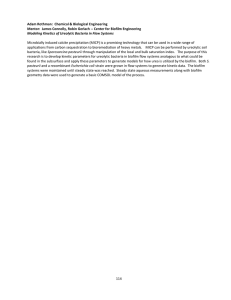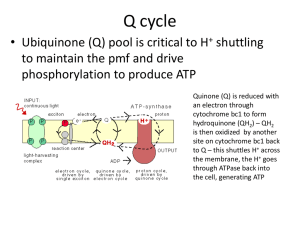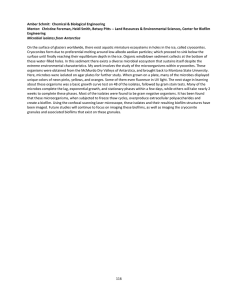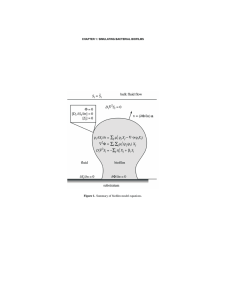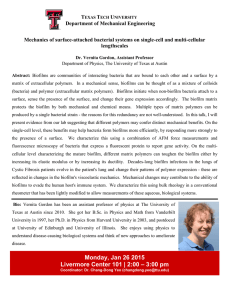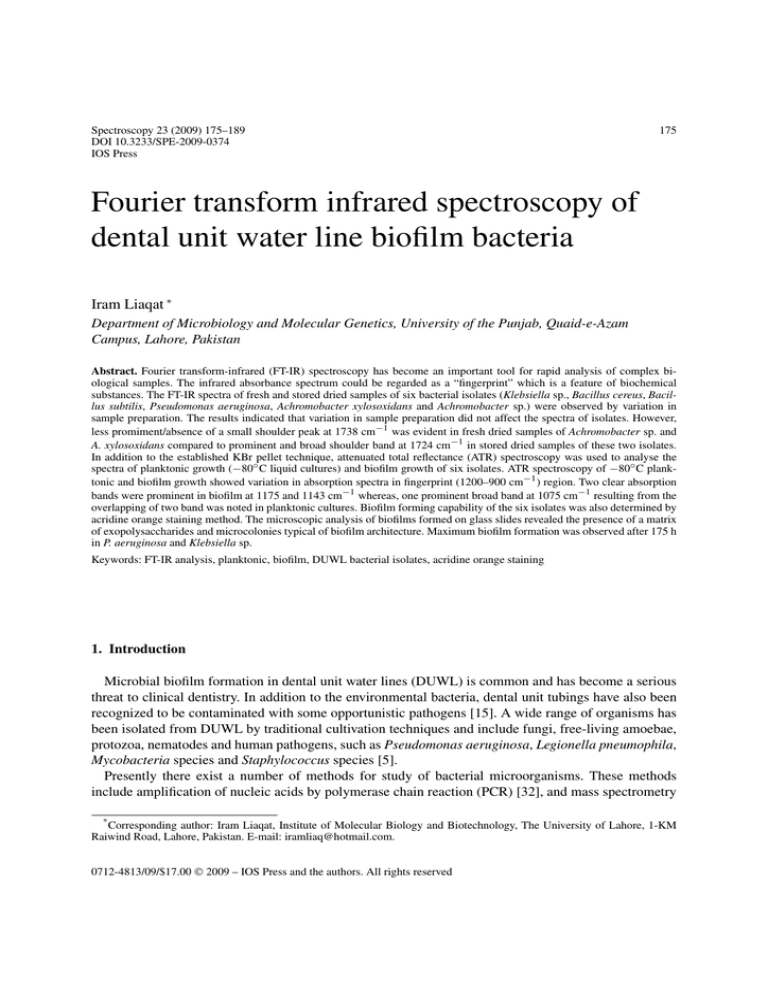
Spectroscopy 23 (2009) 175–189
DOI 10.3233/SPE-2009-0374
IOS Press
175
Fourier transform infrared spectroscopy of
dental unit water line biofilm bacteria
Iram Liaqat ∗
Department of Microbiology and Molecular Genetics, University of the Punjab, Quaid-e-Azam
Campus, Lahore, Pakistan
Abstract. Fourier transform-infrared (FT-IR) spectroscopy has become an important tool for rapid analysis of complex biological samples. The infrared absorbance spectrum could be regarded as a “fingerprint” which is a feature of biochemical
substances. The FT-IR spectra of fresh and stored dried samples of six bacterial isolates (Klebsiella sp., Bacillus cereus, Bacillus subtilis, Pseudomonas aeruginosa, Achromobacter xylosoxidans and Achromobacter sp.) were observed by variation in
sample preparation. The results indicated that variation in sample preparation did not affect the spectra of isolates. However,
less promiment/absence of a small shoulder peak at 1738 cm−1 was evident in fresh dried samples of Achromobacter sp. and
A. xylosoxidans compared to prominent and broad shoulder band at 1724 cm−1 in stored dried samples of these two isolates.
In addition to the established KBr pellet technique, attenuated total reflectance (ATR) spectroscopy was used to analyse the
spectra of planktonic growth (−80◦ C liquid cultures) and biofilm growth of six isolates. ATR spectroscopy of −80◦ C planktonic and biofilm growth showed variation in absorption spectra in fingerprint (1200–900 cm−1 ) region. Two clear absorption
bands were prominent in biofilm at 1175 and 1143 cm−1 whereas, one prominent broad band at 1075 cm−1 resulting from the
overlapping of two band was noted in planktonic cultures. Biofilm forming capability of the six isolates was also determined by
acridine orange staining method. The microscopic analysis of biofilms formed on glass slides revealed the presence of a matrix
of exopolysaccharides and microcolonies typical of biofilm architecture. Maximum biofilm formation was observed after 175 h
in P. aeruginosa and Klebsiella sp.
Keywords: FT-IR analysis, planktonic, biofilm, DUWL bacterial isolates, acridine orange staining
1. Introduction
Microbial biofilm formation in dental unit water lines (DUWL) is common and has become a serious
threat to clinical dentistry. In addition to the environmental bacteria, dental unit tubings have also been
recognized to be contaminated with some opportunistic pathogens [15]. A wide range of organisms has
been isolated from DUWL by traditional cultivation techniques and include fungi, free-living amoebae,
protozoa, nematodes and human pathogens, such as Pseudomonas aeruginosa, Legionella pneumophila,
Mycobacteria species and Staphylococcus species [5].
Presently there exist a number of methods for study of bacterial microorganisms. These methods
include amplification of nucleic acids by polymerase chain reaction (PCR) [32], and mass spectrometry
*
Corresponding author: Iram Liaqat, Institute of Molecular Biology and Biotechnology, The University of Lahore, 1-KM
Raiwind Road, Lahore, Pakistan. E-mail: iramliaq@hotmail.com.
0712-4813/09/$17.00 © 2009 – IOS Press and the authors. All rights reserved
176
I. Liaqat / Fourier transform infrared spectroscopy of dental unit water line biofilm bacteria
[19], etc. However, there is still a need to study those bacteria that pose a risk to public heath. The study
of bacteria by vibrational spectroscopies such as Fourier transform infrared spectroscopy (FT-IR) was
pioneered by Naumann et al. [11]. Since then, FT-IR and Raman spectroscopy have been developed by
several research groups to explore many features of whole microorganisms [2] and have been used to
identify cellular components of both pathogenic and non-pathogenic bacteria [24]. Raman spectroscopy
has been used as a powerful tool whole cell bacterial study. However, compared to FT-IR, this approach
is still not sufficiently developed [34].
FT-IR spectroscopy has become a useful technique and an effective analytical tool for analysing the
chemical composition of biological samples. The principle of FT-IR is based on the vibrational motions
of atoms and chemical bonds within organic molecules. When a beam of light containing the mid-IR
radiation band is passed through a sample, light energy from the photons is absorbed by bonds and
transformed into vibrational motions [18]. Absorption in this region is mostly due to the vibrational
and rotational motions of molecules and therefore used as ‘fingerprint’ of the sample [11]. Different
bonds absorb light at different frequencies giving very specific absorption patterns to various biological components. The mid-infrared region (4000–800 cm−1 ) provides the most important information
biologically [29].
A key advantage of infrared spectroscopy is that FT spectrometers are able to measure infrared spectra
with accuracy in both absorbance and wavenumber of typically about one part in 104 . This, together with
long-term constancy and reproducibility, even very small differences in the composition of biological
materials can be consistently measured and used as a basis for classification and discrimination [34].
FT-IR spectra of bacteria are specific to a given strain and show the spectral characteristics of cell
components, such as lipids, carbohydrates, membrane and intracellular proteins, polysaccharides and
nucleic acids (DNA/RNA). The possibilities of inducing FT-IR spectra are inadequate due to overlapping
of absorption bands specific to specific components of a bacterial cell [4].
Precise and efficient sample preparation is critical for subsequent spectral acquisition by FT-IR spectroscopy [23]. Another concern is to ensure that the sensitivity of the FT-IR analysis is in accordance with
regulatory standards for chemical characterisation of pathogenic bacteria. Sample preparation methods,
FT-IR accessories, and chemometrics all have been considered important in improving the efficiency
of the characterisation of environmental as well as pathogenic bacteria [22]. This study compares the
planktonic growth of isolates with biofilm form using attenuated total reflectance (ATR) FT-IR. ATR
spectroscopy has been described as an excellent technique to investigate biofilm formation because it
may be used to study the chemical composition of smooth surfaces without disrupting the biofilm substratum/liquid interface [6].
FT-IR spectra of bacteria are specific to a given strain and show the spectral characteristics of cell
components, such as lipids, carbohydrates, membrane and intracellular proteins, polysaccharides, and
nucleic acids (DNA/RNA). The possibilities of inducing FT-IR spectra are inadequate due to overlapping of absorption bands specific to specific components of a bacterial cell [4]. The objectives of this
study were therefore: (1) to determine the effect of sample preparation on IR-spectra of DUWL biofilm
isolates (2) to find the ability of ATR FT-IR to distinguish two different modes (planktonic and biofilm)
of isolates. Additionally biofilm forming capability of isolates was determined using acridine orange
staining. The research was conducted on the Bacillus subtilis, B. cereus, Achromobacter xylosoxidans,
Achromobacter sp., Klebsiella sp. and Pseudomonas aeruginosa strains.
I. Liaqat / Fourier transform infrared spectroscopy of dental unit water line biofilm bacteria
177
2. Materials and methods
2.1. Strains and growth conditions
The six bacterial strains used in this study were Klebsiella sp. (DQ989215), Bacillus cereus
(DQ989214), Bacillus subtilis (DQ989210), Pseudomonas aeruginosa (DQ989211), Achromobacter
xylosoxidans (DQ989213) and Achromobacter sp. (DQ989212), which were grown in 100-ml LuriaBertani (LB) medium (10 g bacto tryptone (Difco, UK), 5 g yeast extract (Difco, UK) and 10 g NaCl) to
early stationary phase (18 h). Cell densities were adjusted to an optical density of (OD600 = 1.8), which
corresponded to a population of about 3.10 × 109 CFU/ml. The pH of LB medium was adjusted to 7 by
using 10 mM HEPES (Fisher Scientific, UK) buffer. All cultures were grown at 37◦ C with agitation at
175 rpm.
2.2. Sample preparation
Bacteria were harvested aseptically by centrifugation at 5000 × g for 30 min and at 4◦ C. All strains
were prepared in triplicate. First replicate of each strain was washed twice with 0.85% NaCl, while the
second and third replicates were washed with cold, sterile 20 mM phosphate buffer saline (PBS) (pH 7.5)
and ultra-high purity (UHQ) water, respectively. Each replicate was suspended into its respective washing solution, divided into three equal volumes and centrifuged again at 11,000 × g for 10 min at 4◦ C.
The washed cells were finally resuspended to a concentration of 100 mg wet cells per ml of respective
washing solution (NaCl, PBS or UHQ). Each preparation was then, subjected to oven drying (60◦ C for
30 min), freeze drying (Super Modulo, Edwards High Vacuum International, Crawley, Sussex, England)
for 24 h to a final pressure of 10–20 mmHg (1.3–2.7 Pa) and rotavapor drying (Eppendorf Concentrator 5301, UK) at 30◦ C for 12 h independently before FT-IR measurement. The same procedure was
repeated again to obtain the FT-IR spectra of stored dried samples. The only difference was that pellet
was stored at −80◦ C for 48 h and subjected to oven during, freeze drying and rotavapor drying before
IR spectroscopy.
2.3. FT-IR spectra of fresh and stored dried DUWL samples
For FT-IR in the absorbance mode, cell samples washed in three were ways (PBS, 0.85% NaCl and
DHQ) and subjected to three methods (oven drying, freeze drying and rotavapor drying) were mixed
with KBr (BDH, AnalR; UK), used as dry finely ground powder in a Micro sampling cup (Spectra-Tech
Inc., USA). FT-IR studies were performed using a Perkin-Elmer (Model 2000) with a total of up to
100 scans using a scan range of 4000 and 450 cm−1 and at 4 cm−1 resolution. Other details of spectra
acquisition were mentioned previously [10].
2.4. FT-IR spectra of planktonic and biofilm growth of DUWL isolates
To obtain attenuated total reflectance (ATR) of the planktonic cultures, bacterial strains were grown in
LB supplemented with 50% glycerol stored till mid log phase and stored at −80◦ C for 48 h, harvested
bacterial cultures (1 mg ml−1 ) were dried on a Ge-crystal and the absorption spectra between 4000
and 700 cm−1 were taken using attenuated total reflectance on a FT-IR spectrometer. All spectra were
presented in the region of 2000–800 cm−1 .
178
I. Liaqat / Fourier transform infrared spectroscopy of dental unit water line biofilm bacteria
Biofilm formation of six isolates was monitored following modification of [12]. Briefly 250 µl of
overnight cultures in LBG medium (OD600 = 0.424 ± 0.007) were transferred to 25 ml fresh medium
(1:100). After vortexing, 200 µl were transferred into the wells of a polystyrene tissue-culture-treated
96-well microtiter plate (Corning no. 3595, UK), covered with sealing tape and incubated at 30◦ C and
100 rpm. After 175 h, the growth medium was discarded and microtitre plate wells were washed three
times with 200 µl of 0.85% (w/v) NaCl to remove loosely attached bacteria. The biofilm was scratched
from the wells of microtitre plate with the help of sterile tooth pick, applied in the form of paste on
ATR-crystal and subsequently air dried for 30 min. ATR spectra were then obtained as outlined above.
2.5. Acridine orange staining of DUWL biofilm
Inocula for the cells were prepared as mention above for DUWL biofilm. Sterile glass slides were
aseptically placed into batch tubes along with 25 ml of the inoculated LBG medium and incubated at
30◦ C for 48, 96 and 175 h. The glass slides were removed, rinsed with PBS and stained with 0.01%
acridine orange (Sigma Chemical, St. Louis, MO, 30 mg/ml) for 3 min. Then, glass slides were rinsed
2× with PBS and examined with a Zeiss Axiophot microscope (Carl Zeiss, Gottingen, Germany) in fluorescence mode (FITC narrow). All images were obtained with a ×100 lens objective by using attached
camera (Axiocam MRC). Files for each section from top and bottom surface of glass slides were saved
by computer and software package ImageJ (National Institutes of Health, Bethesda, MD) was used for
image analysis. Experiment was done in triplicate.
2.6. Data processing
All operations on spectra were performed using original Spectrum One 3.01.00 software and saved in
ASCII format, compatible with Excel (Microsoft, USA). Data was normalised to increase the intensities
of band of interest and the area of selected peaks was measured by triangulation method.
3. Results and discussion
3.1. FT-IR spectroscopy of fresh and stored dried DUWL samples
Fourier transform infrared (FT-IR) has been developed for analysing many characteristics of microbiological samples [14]. FT-IR spectroscopy measures vibrations of functional groups of chemicals. The
advantages of this system are minimal sample preparation, rapidity, automated, accurate, in expensive
and quantitative. The absorbance spectrum generated by FT-IR contained valuable information about
the chemical composition of these bacteria [33]. FT-IR spectroscopy has been demonstrated to be an
effective tool to record the infrared spectrum of whole cells, such as bacteria in a film, or even, the spectrum of a single cell [29]. The six bacterial strains examined for FT-IR spectroscopy were isolated from
DUWL biofilm [15]. The results for the spectra indicated that variation in sample preparation has either
no/negligible effect on spectra using KBr disc method.
In Fig. 1(a, b), FT-IR spectra are shown in the region 3500–400 cm−1 for fresh dried samples of
six strains grown in LB medium. These spectra are typical of bacteria and have been assigned previously [33]. They exhibit major bands at around 2900 cm−1 (C–H stretch), 1648 cm−1 (amide I; mainly
C=O stretch), 1548 cm−1 (amide II; N–H bend and C–N stretch), 1456 cm−1 (C–H bend), 1400 cm−1
(partially due to a symmetric stretch of the carboxylate ions), 1235 cm−1 (P=O asymmetric stretch,
I. Liaqat / Fourier transform infrared spectroscopy of dental unit water line biofilm bacteria
179
C−O−C stretch, and amide III (C–N bend and N–H stretch)), and the 1150–900 cm−1 region, referred
to below as the PS band (P=O symmetric stretch, C–C and C–O stretch). The main groups of biomolecules which can be associated with these bands are proteins (amide I, II and III bands), nucleic
acids (regions around 1240 and 1080 cm−1 ), polysaccharides (region from 1150 to 900 cm−1 ), and
lipids (region around 2900 cm−1 ) [3]. Interestingly, it is evident from the figure that variation in sample
preparation resulted in slight variation in the absorption spectra of all isolates. Spectrum is populated
by absorptions arising from OH, C–H stretching vibrations of –CH2 (methylene) and –CH3 (methyl)
groups. The broad bands, observed mostly in oven dried samples in the 3500–3200 cm−1 region of all
samples arise, mainly from the OH stretching bands of water. This may be due to greater interference
of water in these samples (Fig. 1). Hydration and dehydration-induced changes in protein amide bands
have been assigned to structural changes of proteins in the dried state. It has also been implicated that
the removal of water per se can also induce spectral changes of protein FT-IR spectra that may not be
directly related with protein structural changes [35].
The main absorption bands and their peak area values under various conditions of sample treatments
were plotted in Fig. 3. Fresh/stored samples washed with NaCl exhibited a larger peak area compared
to those washed with PBS. The area of band increases in the whole region (3500–400 cm−1 ) from PBS
to NaCl in all stored/fresh samples under various conditions of drying (freeze drying, oven drying and
rotavapour drying). Region 2918 cm−1 corresponding to asymmetric stretching of CH2 mainly due to
lipids region exhibited slight variation in peak area values on sample treatment with PBS and NaCl but
this variation was noticeable among different strains (Fig. 3).
Examples of various FT-IR spectra of the bacteria collected with the KBr disc method of dried fresh
samples are shown in Fig. 1. Minimal qualitative differences were observed between the samples under various culture conditions, however considerable quantitative differences are clearly visible between
the six bacterial strains (Fig. 3). The biggest differences were found between spectra of P. aeruginosa,
Klebsiella sp., B. subtilis and Achromobacter sp. whereas the smallest between B. subtilis and B. cereus,
and A. xylosoxidans and Achromobacter sp. (Fig. 3). The findings of this study are in consistent with
Catherine et al. [6], who reported minimal qualitative differences but considerable quantitative differences between B. cereus C25 and B. subtilis S7 using high throughput FT-IR. Increase peak area values
in Klebsiella sp. at 1647, 1452, 1228 and 1077 cm−1 regions compared to P. aeruginosa was observed.
In B. subtilis, however increased peak areas at 1395, 1228, 1077 cm−1 were observed compared to all
other isolates (Fig. 1). Interestingly, a new peak was observed in stored/fresh dried samples of Achromobacter sp. and in fresh samples of A. xylosoxidans at 1738 cm−1 (Figs 1 and 3). Further, stored dried
samples of P. aeruginosa and Klebsiella sp. exhibited increased peak areas at 1646 cm−1 , whereas in
A. xylosoxidans and Achromobacter sp., increase in peak areas was observed in fresh dried samples
(Fig. 3). The strong band at 1646 cm−1 may contain a contribution from the H–O–H bending (ν2 mode)
band of water. However, other organic compounds including amide 1 may have IR bands in this region.
Numerous other spectral features are present in this region, although unambiguous assignment of these
spectral features needs further investigation by drying samples on CaF2 window at the present time.
The absorption bands 1534–1545 cm−1 corresponding amide II bands of cellular proteins respectively
dominated in dried samples of all strains. The bands at 1646 and 1545 cm−1 of the fresh/stored samples
showed some variations which may be linked to the variation in the proteins of cells during drying under
various conditions (Fig. 3). It has already been mentioned that the bands represented an average of all
the proteins in the cells, and the cells might be inactivated only from changes in a few important proteins
[2,31]. There was a weak shoulder at 1722–1724 cm−1 corresponding to ester ν(C=O) band, observed
in fresh dried samples of Achromobacter sp. and A. xylosoxidans. While slight shifting of this shoulder
180
I. Liaqat / Fourier transform infrared spectroscopy of dental unit water line biofilm bacteria
Fig. 1. (a) FT-IR spectroscopy of (I) fresh and (II) stored dried samples from six DUWL biofilm isolates. Samples were washed
with H2 O, NaCl and PBS and subjected to freeze drying (F.D), oven drying (O) and rotavapour drying (R). Data was normalized
to the value 1.0 in relation to the largest absorbance value.
I. Liaqat / Fourier transform infrared spectroscopy of dental unit water line biofilm bacteria
181
Fig. 1. (b) FT-IR spectroscopy of (I) fresh and (II) stored dried samples from six DUWL biofilm isolates. Samples were
prepared in triplicates and washed independently with H2 O, NaCl and PBS subjected to freeze drying (F.D), oven drying (O)
and rotavapour drying (R). Data was normalized to the value 1.0 in relation to the largest absorbance value.
182
I. Liaqat / Fourier transform infrared spectroscopy of dental unit water line biofilm bacteria
band to 1738 cm−1 in stored dried sample of Achromobacter sp. was observed. In A. xylosoxidans, however, it was absent (Fig. 1(b)). It has been reported earlier [1] that the position of the ν(C=O) band under
1730 cm−1 corresponds to that of pure poly-3-hydroxybutyrate (PHB) found in many bacterial cells [31],
whereas other polyhydroxyalkanoates (PHAs) exhibit bands at 1732–1740 cm−1 [20]. Considering the
visible “left-hand” asymmetry of the ester ν(C=O) band in this study with maxima at about 1724 cm−1 ,
the presence of PHAs other than the dominating PHB is probable. Under normal nutritional conditions
with aeration its biosynthesis is decreased [10]. Thus, accumulation of PHB and other PHAs in cells of
bacteria under unfavourable conditions might be playing a role in bacterial tolerance to environmental
stresses.
Together with an increased FT-IR absorption in the regions of CH2 bending vibrations (at 1444–
1450 cm−1 ), these spectroscopic changes provide evidence for the accumulation of polyester compounds
in cells of all DUWL biofilm strains (Fig. 1(a, b)). In addition, the position of a weak band was observed at 1239–1243 cm−1 (ν as (PO2 − )) in fresh and stored dried sample of Klebsiella sp. and B. cereus
(Fig. 1(a, b)) while ν as (PO2 − ) band shifted to 1225–1230 cm−1 in fresh/stored samples of Klebsiella sp.,
Achromobacter sp., A. xylosoxidans and P. aeruginosa (Fig. 1(a, b)) thus featuring the transition from
the dehydrated or medium-hydrated state to a higher hydration of phosphate moieties [1].
From information obtained from previous studies [28,30], remaining IR bands were assigned as follows: in 1200–900 cm−1 spectral region shoulder like bands at 1235 and 1082 cm−1 were attributed to
PO−2 asymmetric and symmetric stretching vibrations and phospholipids (Fig. 1(a, b)). The shoulder
band at 1052–1064 cm−1 in all six isolates resulted from the overlap of several bands, including absorption due to the vibration modes of CH2 OH and the C–O stretching vibration coupled to the C–O bending
mode of cell carbohydrates (Fig. 1).
3.2. Attenuated total reflectance (ATR) spectroscopy of DUWL isolates in liquid and biofilm mode
Attenuated total reflectance (ATR) spectroscopy was used for differentiating among the spectra to
obtain spectra of planktonic (−80◦ C) liquid cultures and bacterial samples grown in biofilm mode in
96-well plates. The results showing the spectra from six isolates were presented in Fig. 2(a, b). It can
be seen, like planktonic bacteria, that there is a good similarity in the spectra of these different bacterial biofilms. However, there are striking differences in cells grown. Interestingly, the band relative
intensities in the spectra in the in planktonic and biofilm growth were different, and in particular, in the
1200–900 cm−1 region (amide I, II) in the biofilm spectrum and this ratio varied with the age and the
physiological state of biofilm, as discussed further below. The dominant bands at 1643–1544 cm−1
observed in biofilm growth and 1637–1544 cm−1 in planktonic cultures were attributed to protein
amide I and II bands. The amide band II is a vibration related to N–H bend+ C–N stretch of the peptide
bond [33].
The author is first to report the attenuated total reflectance-FT-IR study of DUWL isolates in biofilm
mode by growing them in microtitre plates. Interestingly, in all the six samples, in both modes, there was
a weak shoulder at about 1724–1736 cm−1 , which indicated the accumulation of PHB and other PHAs
as already reported by [1]. Since the isolates in planktonic cultures were stored at −80◦ C as glycerol
stocks for 48 h and in the biofilm growth, these were growing in microtitre plates without replenishing
with fresh media for 175 h. Thus, presence of this shoulder was pointing towards bacterial strategy to
cope with unfavourable conditions [1]. Moreover, ν as (PO2 − ) band of cellular phosphate moieties was
constantly present in all isolates in biofilm growth but it was not observed in planktonic cultures thus
confirming relative instability of the state of this functional group in planktonic and biofilm mode. In
I. Liaqat / Fourier transform infrared spectroscopy of dental unit water line biofilm bacteria
183
Fig. 2. Attenuated total reflectance FT-IR spectroscopy of (a) microtitre plate biofilm and (b) liquid cultures (stored at −80◦ C) of
six DUWL isolates (I, A. xylosoxidans; II, Achromobacter sp.; III, B. cereus; IV, B. subtilis; V, P. aeruginosa; VI, Klebsiella sp.).
Data was normalized to the value 1.0 in relation to the largest absorbance value.
184
I. Liaqat / Fourier transform infrared spectroscopy of dental unit water line biofilm bacteria
Fig. 3. The peak area alteration of selected bands of fresh and stored dried DUWL samples under various conditions (freeze
drying, oven drying and rotavapour drying) of sample preparation. F.PBS, Fresh sample washed with PBS; F.NaCl, Fresh
sample washed with NaCl; S.PBS, Stored sample washed with PBS; S.NaCl, stored sample washed with NaCl.
I. Liaqat / Fourier transform infrared spectroscopy of dental unit water line biofilm bacteria
185
a study by Yu and Irudayaraj [9], band 1453 cm−1 was predominantly found in the FT-IR spectrum of
the cell envelope compared with that of the cytoplasm of bacterial cells. Based upon this observation,
band 1453–1454 cm−1 should be related to membrane lipid [7]. The bands at 1394 cm−1 represents
C=O symmetric stretching of COO– [21] and assigned to lipids [28].
Figure 4 summarizes the differences in the peak areas of biofilm cells and planktonic cells. An increase
in the peak areas at 1731, 1452 and 1178 cm−1 regions was observed in biofilm cells compared to planktonic cells. Whereas increased peak areas at 2929, 1647, 1542 and 1395 cm−1 regions were observed
in planktonic cells (Fig. 4). A possible origin of the observed spectral heterogeneity peaks might then
be ascribed to differences in the cells growing in two different states i.e., planktonic and biofilm mode
[3,13]. Absorption spectra in the 1200–900 cm−1 affected greatly during biofilm growth of bacterial
isolates. Indeed, during biofilm formation the whole 1200–900 cm−1 region gradually rises (Fig. 2(a),
Table 2). Whilst the stronger bands in B. subtilis might be because of the presence of teichoic acids [25],
the stronger band intensities/peak areas could be attributed to the differences in metabolic state and aging of the cells during the course of biofilm formation [13]. It is also well-known that the attachment of
some bacteria to surfaces and their permanent adhesion involves the formation of glycocalyx. Therefore,
biofilm formation may induce the appearance of these polysaccharide fibers [25]. These results are in
agreement with a previous study by Delille et al. [3], who reported the ATR–FT-IR spectra acquired
over 3 h period of biofilm formation in P. fluorescens were similar to planktonic bacterium spectra, in
particular, regarding the relative intensities and the amide II/PS band intensity ratio. They illustrated that
for the amide II band, the intensity of all bands increased with time due to accumulation of biomass
and an increase in the surface coverage by bacteria, further confirmed by optical microscopy. Comparison of all 6 biofilm spectra recorded shows that the spectrum recorded displays the strong absorption
bands at 1043 and 1175 cm−1 in biofilm growth which mainly originates from nucleic acids (Fig. 2(a)).
Further the area at 1178 cm−1 increase in biofilm mode compared to planktonic growth as shown in
Fig. 4. In fact, important physiological changes in bacteria enhance their metabolic activity as soon as
they become attached to a surface [13]. It might be due to an increase of the complex sugar band located between 1200–900 cm−1 which represents the extra and/or the intracellular polysaccharides [25].
In B. subtilis, stronger bands might be because of the presence of teichoic acids [27].
3.3. Observation and analysis of biofilm by acridine orange staining
Due to the fact, that spectral variations were observed in bacteria growing in biofilm mode, acridine
orange was used to visualize the biofilm formation microscopically after 175 h. Acridine orange, a fluorochrome strain, is potentially better in the direct microscopic examination of clinical specimens because
it gives striking differential staining between bacteria and background cells and debris [14]. For all isolates, as the incubation time extended, the number of attached bacteria increased throughout the abiotic
surface [24]. Figure 5(a) shows the process of colonization on glass slides, after 175 h following growth
in inoculated LB medium. The biofilm determination on the top and bottom side of each glass slide
permitted the monitoring of the microbial colonization. Strains varied in their ability to form biofilm and
maximum biofilm forming capability on glass slides was observed in P. aeruginosa and Klebsiella sp.
after 175 h (Fig. 5(a), III and VI).
The acridine orange binds with bacterial RNA and DNA and emits red (in single-stranded nucleic acid)
and green (in double-stranded nucleic acid) fluorescence [16]. Cells in the log phase emit red fluorescence, whereas those in the stationary phase emit a green one. This acridine orange ability has also been
used to analyse the bacterial metabolism in planktonic cells and in biofilms [17]. The DUWL isolates
186
I. Liaqat / Fourier transform infrared spectroscopy of dental unit water line biofilm bacteria
Fig. 4. The peak area alteration of selected bands of DUWL isolates in liquid and biofilm mode.
I. Liaqat / Fourier transform infrared spectroscopy of dental unit water line biofilm bacteria
187
(a)
(b)
Fig. 5. (a) Acridine orange staining of biofilm formed by DUWL isolates (I) Achromobacter sp., (II) A. xylosoxidans,
(III) P. aeruginosa, (IV) B. subtilis, (V) B. cereus and (VI) Klebsiella sp. on glass slides after 175 h. (b) Measurement of
biofilm area coverage by six DUWL biofilm isolates on top surface () and bottom surface () of glass slides after 48, 96 and
175 h.
biofilm showed very high quantity of RNA in the biofilm cells, indicating high metabolic activity [24].
However, the lack of equivalent metabolic investigations regarding naturally formed oral biofilms limits
the importance of this finding. Related to free-living and in vitro-grown biofilms, this could be a sign
of biofilm immaturity, despite the multiplayer structure and developed matrix. The biofilm immaturity
might be explained with the relatively short period of biofilm development of no more than 175 h (in fact
188
I. Liaqat / Fourier transform infrared spectroscopy of dental unit water line biofilm bacteria
limited by the exfoliation), depletion of nutrient supply, however, this requires further investigations.
At the first stages, the glass slides were rapidly colonized and appeared to form a monolayer biofilm.
When the biofilm matured, between 96 and 175 h (data not shown), it was possible to differentiate some
cell clusters, and rich bacterial growth was observed in the previously uncolonized zones. After 175 h,
greatly enhanced biofilm formation (%) at the bottom surface was observed in all isolates except for
B. cereus which was relatively poor biofilm former (Fig. 5(b)). At this stage a low basal layer of cells
could be distinguished, with stacks of biofilm coming up from the surface in P. aeruginosa, B. subtilis, Klebsiella sp., Achromobacter sp. and A. xylosoxidans (Fig. 5(a)). The qualitative data reported
here demonstrate maximum capacity to form biofilm on glass slides in Klebsiella sp. and P. aeruginosa
(Fig. 5(b)). It might be due to secretion of extracellular polysaccharide matrix (EPS). EPS is thought to
be an important factor for the process of bacterial attachment to abiotic surfaces [26]. EPS of biofilms
consist largely of polysaccharides, in addition to nucleic acids and proteins [8]. Alternatively, the hydrophobicities and surface charges of bacteria play an important role in bacterial attachment to abiotic
surfaces. These properties differ between species, serotypes or strains, and can change with variation
in growth conditions, physiological state of cells, as well as composition of suspension medium [26],
hence contributing to strong or relatively weak biofilm formation in different DUWL isolates.
4. Conclusion
In conclusion, the present study showed obtained spectra of the bacterial biofilms, pointed on several
spectral bands which could be considered as unique for biofilms. These bands might be considered as
reliable biomarkers to be developed for future rapid discrimination between bacteria in their biofilm
growth and contribute important information in the development of persistent strains within clinical
environments. This rapid discrimination could be highly significant in the case of clinical samples obtained from unidentified infections. Further studies on this aspect will be necessary to understand the
mechanism of biofilm growth among DUWL isolates. In addition, acridine orange staining showed the
maximum biofilm forming capability of DUWL biofilm isolates after 175 h on the bottom surface of
glass slides. In this study, biofilm growth, however, was examined in batch cultures, not beyond 175 h
incubation time. It is possible that increased incubation time with replenishing of fresh media would
result in biofilms highly similar in terms of numbers of colonized viable cells.
Acknowledgements
The author wish to thank Robert T. Bachmann and Jesus J. Ojeda (University of Sheffield, UK) for
their technical support and helpful discussions. This work was supported by scholarship awarded by
Higher Education Commission (HEC), Pakistan.
References
[1] A.A. Kamnev, A.V. Tugarova, L.P. Antonyuk, P.A. Tarantilis, L.A. Kulikov, Y.D. Perfiliev, M.G. Polissiou and P.H. Gardiner, Anal. Chim. Acta 573/574 (2006), 445–452.
[2] A.C. Singer, W.E. Huang, J. Helm and I.P. Thompson, J. Microbiol. Methods 60 (2005), 417–422.
[3] A. Delille, F. Quilès and F. Humbert, Appl. Environ. Microbiol. 73 (2007), 5782–5788.
I. Liaqat / Fourier transform infrared spectroscopy of dental unit water line biofilm bacteria
189
[4] A. Bosch, M.A. Golowczyc, A.G. Abraham, G.L. Garrote, G.L. De Antoni and O. Yantorno, Int. J. Food Microbiol. 111
(2006), 280–287.
[5] C.L. Pankhurst, Risk assessment of dental unit waterline contamination, Prim. Dent. Care 10 (2003), 5–10.
[6] C.L. Winder and R. Goodacre, Analyst 129 (2004), 1118–1122.
[7] C. Santivarangkna, M. Wenning, P. Foerst and U. Kulozik, J. Appl. Microbiol. 102 (2007), 748–756.
[8] C.S. Laspidou and B.E. Rittmann, Water Res. 36 (2002), 2711–2720.
[9] C. Yu and J. Irudayaraj, Biopolymers 77 (2005), 368–377.
[10] D. Kadouri, E. Jurkevitch and Y. Okon, Appl. Environ. Microbiol. 69 (2003), 3244–3250.
[11] D. Naumann, D. Helm and H. Labischinski, Nature 351 (1991), 81–82.
[12] G.D. Christensen, W.A. Simpson, J. Younge, L.M. Baddour, F.F. Barrett, D.M. Melton and E.H. Beachey, J. Clin. Microbiol. 22 (1985), 996–1006.
[13] G.G. Geesey and D.C. Uhite, Determination of bacterial growth and activity at solid liquid interfaces, Annu. Rev. Microbiol. 44 (1990), 579–602.
[14] H. Oberreuter, J. Charzinski and S. Scherer, Microbiology 148 (2002), 1523–1532.
[15] I. Liaqat and A.N. Sabri, Curr. Microbiol. 56 (2008), 619–624.
[16] J.G. Bruno, S.A. Sincock and P.J. Stopa, Biotech. Histochem. 71 (1996), 130–136.
[17] K.D. Xu, G.A. McFeters and P.S. Stewart, Microbiology 146 (2000), 547–549.
[18] K. Hong, S. Sun, W. Tian, G.Q. Chen and W. Huang, Appl. Microbiol. Biotechnol. 51 (1999), 523–526.
[19] K.L. Wahl, S.C. Wunschel, K.H. Jarman, N.B. Valentine, C.E. Petersen, M.T. Kingsley, K.A. Zartolas and A.J. Saenz,
Anal. Chem. 74 (2002), 6191–6199.
[20] K.M. Gough, D. Zelinski, W.R. Wiens, M. Rak and I.M. Dixon, Anal. Biochem. 316 (2003), 232–242.
[21] K. Maquelin, L.P. Choo-Smith, C. Kirschner, N.A. Ngo-Thi, D. Naumann and G.J. Puppels, Handbook of Vibrational
Spectroscopy, Wiley, Chichester, UK, 2001.
[22] K. Maquelin, L.P. Choo-Smith, C. Kirschner, N.A. Ngo-Thi, D. Naumann and G.J. Puppels, J. Clin. Microbiol. 41 (2003),
324–329.
[23] L.M. Miller and P. Dumas, Biochim. Biophys. Acta 1758 (2006), 846–857.
[24] L. Vitkov, M. Hannig, W.D. Krautgartner, M. Herrmann, K. Fuchs, M. Klappacher and A. Hermann, Lett. Appl. Microbiol.
41 (2005), 404–411.
[25] L.A.S. Parolis, H. Parolis, G.G.S. Dutton, P.L. Wing and J.J. Skura, Carbohyd. Res. 216 (1991), 495–504.
[26] M.S. Chae, H. Schraft, H.L. Truelstrup and R. Mackereth, Food Microbiol. 23 (2006), 250–259.
[27] M. Wei, J.H. Evans, T. Bostrom and L. Grondahl, J. Mater. Sci. Mater. Med. 14 (2003), 311–320.
[28] P. Wong, S. Goldstein, R. Grekin, A. Godwin, C. Pivik and B. Riga, Cancer Res. 53 (1993), 762–765.
[29] R. Goodacre, B. Shann, R.J. Gilbert, E.M. Timmins, A.C. McGovern, B.K. Alsberg, D.B. Kell and N.A. Logan, Anal.
Chem. 72 (2000), 119–127.
[30] R.K. Dukor, Handbook of Vibrational Spectroscopy, Wiley, Chichester, UK, 2001.
[31] S. Khanna and A.K. Srivastava, Process Biochem. 40 (2005), 607–619.
[32] S. Makino and H. Cheun, J. Microbiol. Methods 53 (2003), 141–147.
[33] V. Erukhimovitch, V. Pavlov, M. Talyshinsky, Y. Souprun and M. Huleihel, J. Pharm. Biomed. Anal. 37 (2005), 1105–
1108.
[34] W.E. Huang, D. Hopper, R. Goodacre, M. Beckmann, A. Singer and J. Draper, J. Microbiol. Methods 67 (2006), 273–280.
[35] W.F. Wolkers and H. Oldenhof, Spectroscopy 19 (2005), 89–99.
International Journal of
Medicinal Chemistry
Hindawi Publishing Corporation
http://www.hindawi.com
Volume 2014
Photoenergy
International Journal of
Organic Chemistry
International
Hindawi Publishing Corporation
http://www.hindawi.com
Volume 2014
Hindawi Publishing Corporation
http://www.hindawi.com
Volume 2014
International Journal of
Analytical Chemistry
Hindawi Publishing Corporation
http://www.hindawi.com
Volume 2014
Advances in
Physical Chemistry
Hindawi Publishing Corporation
http://www.hindawi.com
Volume 2014
International Journal of
Carbohydrate
Chemistry
Hindawi Publishing Corporation
http://www.hindawi.com
Journal of
Quantum Chemistry
Hindawi Publishing Corporation
http://www.hindawi.com
Volume 2014
Volume 2014
Submit your manuscripts at
http://www.hindawi.com
Journal of
The Scientific
World Journal
Hindawi Publishing Corporation
http://www.hindawi.com
Journal of
International Journal of
Inorganic Chemistry
Volume 2014
Journal of
Theoretical Chemistry
Hindawi Publishing Corporation
http://www.hindawi.com
Hindawi Publishing Corporation
http://www.hindawi.com
Volume 2014
Spectroscopy
Hindawi Publishing Corporation
http://www.hindawi.com
Analytical Methods
in Chemistry
Volume 2014
Hindawi Publishing Corporation
http://www.hindawi.com
Volume 2014
Chromatography Research International
Hindawi Publishing Corporation
http://www.hindawi.com
Volume 2014
International Journal of
Electrochemistry
Hindawi Publishing Corporation
http://www.hindawi.com
Volume 2014
Journal of
Hindawi Publishing Corporation
http://www.hindawi.com
Volume 2014
Journal of
Catalysts
Hindawi Publishing Corporation
http://www.hindawi.com
Journal of
Applied Chemistry
Hindawi Publishing Corporation
http://www.hindawi.com
Bioinorganic Chemistry
and Applications
Hindawi Publishing Corporation
http://www.hindawi.com
Volume 2014
International Journal of
Chemistry
Volume 2014
Volume 2014
Spectroscopy
Volume 2014
Hindawi Publishing Corporation
http://www.hindawi.com
Volume 2014

